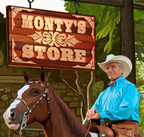I can rub him on both sides, most of the time, from head to middle of his back and down his front legs. I am doing advance and retreat. His MO is to go away first and then come over.
I need advice as to how I can get a halter on him so I can start ground work. I did not have a round pen but now I do.
Thanks,
Gera Brown




I took your advice and looked at the Mijo thread. It was very helpful. I feel I should give everyone a little more detail on my guy, El Rito Negro, or Rito for short.
He was culled from a herd of mustangs in the El Rito ranger district of northern New Mexico. From there he and 25 others were moved to a holding facility in Bloomfield, NM. while there he was freeze branded and gelded. That was in February of 2017 as a 2 year old.
In September of 2017 he was brought with one other slightly older gelding from his herd and an 8 and 1/2 year old, now gelded, mustang from a different HMA back to the Tres Piedras,NM ranger station.
When I went to pick him up it was mentioned that Bloomfield had trimmed his hooves before sending him back north. This seemed odd to me so I contacted Bloomfield and asked how this was accomplished.
I was very nonchalantly told that they put him in a squeeze chute, turn him on his side, the floor falls open and someone grabs his feet and trims them. I then understood why he was so afraid of people.
It has taken me months to get to the left side where his freeze brand is and I'm amazed that I can now run my hands down his front legs, although I have not tried to lift them up yet.
I have him in a small area and he can interact with my 15 year old mare across the fence. My back area is about an acre of enclosed dry lot that has pinõn trees.
After about 3 months I felt that he was getting depressed in his small area and I started letting him in the big area with my mare.I do feed them in their respective areas and only let him in with my mare when I am around. At night he is always on his side. I'm not sure if that is good or bad to do, but it seemed that when I initially did that it instilled more trust in him towards me.
I guess we are doing pretty good and that most of my anxiety comes from not wanting to ruin him with my lack of knowledge. I found that the breathing works wonders and as soon as I started that he was more confident to move towards me.
I tend to be high energy even when I think I am being really calm, so I know this is something I need to be aware of at all times. I work 4 days a week and sometimes beat myself up because I don't have more time to spend with him, but I am gleaning from your advice that small amounts of time are what a young horse does best with.
I thought because I was at my mares birth that I knew something about training young horses but have learned from Rito, that the ones born in the wild are a quite different animal.
Thanks and please feel free to give me any advice and knowledge you have to offer. Know that it is greatly appreciated.
Gera